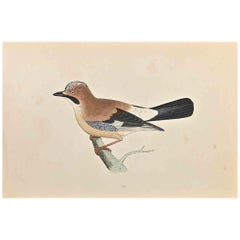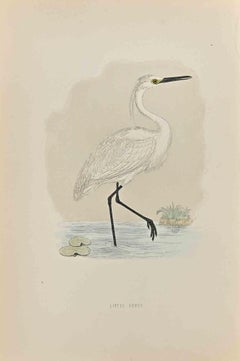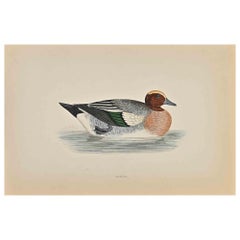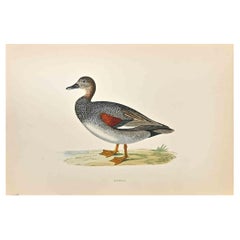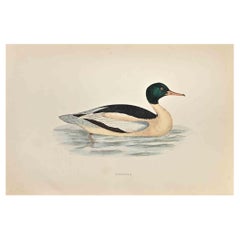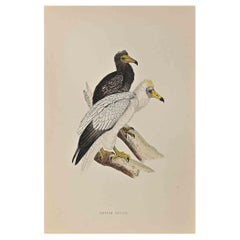1870s Art
to
193
1,186
298
91
42
47
Overall Width
to
Overall Height
to
7,527
21,109
157,420
233,642
1,954
2,291
4,852
6,394
5,758
13,025
19,161
25,439
18,027
13,702
5,359
980
125
61
3
2
1
1
1
1,014
607
5
663
366
356
342
338
290
271
177
170
170
145
88
86
66
65
61
58
57
49
47
512
421
327
299
209
39
14
10
9
8
283
1,120
978
406
Period: 1870s
Jay - Woodcut Print by Alexander Francis Lydon - 1870
Located in Roma, IT
Jay is a modern artwork realized in 1870 by the British artist Alexander Francis Lydon (1836-1917).
Woodcut print on ivory-colored paper.
Hand-colored, published by London, Bell & ...
Category
Modern 1870s Art
Materials
Woodcut
Little Egret - Woodcut Print by Alexander Francis Lydon - 1870
Located in Roma, IT
Little Egret is a modern artwork realized in 1870 by the British artist Alexander Francis Lydon (1836-1917).
Woodcut print on ivory-colored paper.
Hand-colored, published by London...
Category
Modern 1870s Art
Materials
Woodcut
Wigeon- Woodcut Print by Alexander Francis Lydon - 1870
Located in Roma, IT
Wigeon is a modern artwork realized in 1870 by the British artist Alexander Francis Lydon (1836-1917).
Woodcut print on ivory-colored paper.
Hand-colored, published by London, Bell...
Category
Modern 1870s Art
Materials
Woodcut
Gadwall - Woodcut Print by Alexander Francis Lydon - 1870
Located in Roma, IT
Gadwall is a modern artwork realized in 1870 by the British artist Alexander Francis Lydon (1836-1917) .
Woodcut print, hand colored, published by London, Bell & Sons, 1870. Name...
Category
Modern 1870s Art
Materials
Woodcut
Goosander - Woodcut Print by Alexander Francis Lydon - 1870
Located in Roma, IT
Goosander is a modern artwork realized in 1870 by the British artist Alexander Francis Lydon (1836-1917) .
Woodcut print, hand colored, published by London, Bell & Sons, 1870. Nam...
Category
Modern 1870s Art
Materials
Woodcut
Egyptian Vulture - Woodcut Print by Alexander Francis Lydon - 1870
Located in Roma, IT
Egyptian Vulture is a modern artwork realized in 1870 by the British artist Alexander Francis Lydon (1836-1917) .
Woodcut print, hand colored, publi...
Category
Modern 1870s Art
Materials
Woodcut
Scaup - Woodcut Print by Alexander Francis Lydon - 1870
Located in Roma, IT
Scaup is a modern artwork realized in 1870 by the British artist Alexander Francis Lydon (1836-1917) .
Woodcut print, hand colored, published by London, Bell & Sons, 1870. Name of...
Category
Modern 1870s Art
Materials
Woodcut
$165 Sale Price
30% Off
Cave Rue de l'Enfer - Original Etching by Augustin André Lançon - 1871
Located in Roma, IT
Cave Rue de l'Enfer is an original Etching realized by Augustin André Lançon in 1871.
Rare etching belonging to the suite "Guerre de 1870 et Siège de Paris".
Very good Conditions.
...
Category
Old Masters 1870s Art
Materials
Etching
L'homme endormi a l'entree d'un bois, Heliogravure by Marcantonio Raimondi
Located in Long Island City, NY
Marcantonio Raimondi, After by Amand Durand, Italian (1480 - 1534) - L'homme endormi a l'entree d'un bois, Year: 1875, Medium: Heliogravure, Size: 4.25 x 3.25 in. (10.8 x 8.26 cm)...
Category
Old Masters 1870s Art
Materials
Etching
Disparate Fúnebre - Etching - 1875
Located in Roma, IT
Disparate fúnebre - from Los Proverbios is an original black and white etching realized by Francisco Goya (1746-1828).
The artwork is the plate n. 18 ...
Category
Old Masters 1870s Art
Materials
Etching, Aquatint
Cavalry review of the 2nd Lancers regiment
Located in BELEYMAS, FR
Georges HYON
(Paris 1840 – Saint Germain en Laye 1913)
Cavalry review of the 2nd Lancers regiment
Oil on canvas
H. 115 cm; W. 146.5 cm
Signed lower left
A student of Portalis, Georg...
Category
French School 1870s Art
Materials
Canvas, Oil
Young girl - Original etching, Signed (Venturi #1160)
By Paul Cézanne
Located in Paris, IDF
Paul Cézanne
Young girl, 1873
Original etching and roulette
Signed in plate "P. Cézanne" and dated 1873 in lower right corner
On vellum 32 x 25 cm (c. 13 x 10")
REFERENCES :
- Cat...
Category
Impressionist 1870s Art
Materials
Etching
Le Grelot - Le Manifeste Orléaniste - Original Lithograph - 1887
Located in Roma, IT
Le Grelot - Le Manifeste Orléaniste - is an original Modern Artwork realized in 1887.
Original Lithograph on paper.
Passepartout is included.
Dimensions: 70 x 50 cm.
Fair conditi...
Category
Modern 1870s Art
Materials
Lithograph
Venus et l'Amour I, Heliogravure by Marcantonio Raimondi
Located in Long Island City, NY
Marcantonio Raimondi, After by Amand Durand, Italian (1480 - 1534) - Venus et l'Amour I, Year: 1875, Medium: Heliogravure, Size: 4.75 x 3.25 in. (12.07 x 8.26 cm), Printer: Amand ...
Category
Old Masters 1870s Art
Materials
Etching
L'homme et la femme aux boules, Heliogravure by Marcantonio Raimondi
Located in Long Island City, NY
Marcantonio Raimondi, After by Amand Durand, Italian (1480 - 1534) - L'homme et la femme aux boules, Year: 1875, Medium: Heliogravure, Size: 6 x 4 in. (15.24 x 10.16 cm), Printer:...
Category
Old Masters 1870s Art
Materials
Etching
The Bridge, Santa Maria
Located in New York, NY
James Whistler (1834-1903), The Bridge, Santa Marta, 1879-80, etching with drypoint, printed in sepia on fine laid paper. Signed with the butterfly and inscribed imp on the tab (also with an exceedingly light butterfly lower right in the plate). Kennedy 204, probably eighth (final) state; Glasgow 201, probably state 9 (of 9) (cf. Margaret F. MacDonald, Grischka Petri, Meg Hausberg, and Joanna Meacock, James McNeill Whistler: The Etchings, a catalogue raisonné, University of Glasgow, 2011), Lochnan 199. Trimmed to the platemark by the artist, h: 11.8 x w: 7.9 in / h: 30 x w: 20.1 cm.
A fine impression, printed with subtle tone.
The bridge theme occurs repeatedly in Whistler’s vistas. It is also the main focus of more than one of the Venetian prints. While some bridges are seen from below, from where one would see it if approaching in a gondola (for example Ponte del Piovan, Kennedy 209), The Bridge depicts the scene from a high perspective, opening up the view into the far distance. The small boat approaching the arch in the foreground is again, as in the earlier Thames prints, a stock motif that is probably ultimately derived from the Japanese woodcuts of Hokusai and Hiroshige. The bridge here is the Ponte de le Terese over the Rio de l’Arzere in the Santa Marta quarter.
The early biography of Whistler by Elizabeth and Joseph Pennell is essential for its “immense quantity of information” but also notorious for “the inherent hyperbole and misinformation” (Eric Denker, Annotated Bibliography, in Fine, p. 184). Still, it is worth quoting from the Pennels’ appraisal of The Bridge: “Simplicity of expression has never been carried further. Probably the finest plate, in its simplicity and directness, is The Bridge. Whistler now obtained the quality of richness by suggesting detail, and also by printing. In The Traghetto...
Category
Impressionist 1870s Art
Materials
Drypoint, Etching
Man of War. The Fleet in action.
By William Calcott Knell
Located in Douglas, Isle of Man
William Calcott Knell 1830-1880, was a British painter of maritime subjects. His father was William Adolphus Knell 1801-1875 who was also a marit...
Category
1870s Art
Materials
Paper, Watercolor, Pencil
Rainbow Trout -Late 19th Century New England Still Life. Naturalist Oil Painting
By Walter Brackett
Located in Marco Island, FL
A finely executed late 19th-century still life by Walter Brackett (1823-1919) of a rainbow trout with rod and reel in the foreground, along with the fly that captured the trout. Fin...
Category
American Realist 1870s Art
Materials
Canvas, Oil
Composant les dessins pour l'apocalypse de Saint Jean, Etching by Jean Duvet
Located in Long Island City, NY
Jean Duvet, After by Amand Durand, French (1485 - 1562) - Composant les dessins pour l'apocalypse de Saint Jean, Medium: Heliogravure, Size: 10.5 x 7 in. (26.67 x 17.78 cm), Printe...
Category
Old Masters 1870s Art
Materials
Etching
Auguste Gardanne (1840-1890) Carriages and horses, War of 1870, double sided
Located in Paris, FR
Auguste Gardanne (circa 1840- circa 1890)
Carriages and horses during the franco-prussian war of 1870
Pencil and watercolor on paper
On the reverse Studies of horses
Pencil and water...
Category
1870s Art
Materials
Watercolor
Antique SUNSET VIEW OF SAN LAZZARO, VENICE
Located in New York, NY
Up for sale is a wonderful Italian Venetian Sunset painting by Bernhard Stange (1807-1880).
Painting for sale depicts SUNSET VIEW OF SAN LAZZARO, VENICE
It is absolutely colorful a...
Category
Academic 1870s Art
Materials
Oil
Working Horses in a Landscape - Dutch Victorian animal art equine W/C painting
Located in Hagley, England
This lovely Victorian animal landscape watercolour painting is by Dutch artist Johannes Martinus Vrolyk or Vrolijk. Painted in 1875, the painting is of two working horses, one white ...
Category
Realist 1870s Art
Materials
Watercolor
Cleopatre, Old Masters Heliogravure Etching by Marcantonio Raimondi
Located in Long Island City, NY
Marcantonio Raimondi, After by Amand Durand, Italian (1480 - 1534) - Cleopatre, Year: 1875, Medium: Heliogravure, Size: 4.75 x 7 in. (12.07 x 17.78 cm), Printer: Amand Durand, Des...
Category
Old Masters 1870s Art
Materials
Etching
Nepenthes in Ampolla - Lithograph by Vincenzo Tenore - 1870s
Located in Roma, IT
Lithograph hand watercolored.
Belongs to the Series "Atlante di Botanica popolare ossia Illustrazione di Piante Notevoli di ogni famiglia" (Atlas of popular botany or illustration o...
Category
Modern 1870s Art
Materials
Lithograph
Antique British Oil Painting of the Alhambra by Thompson
Located in London, GB
Antique British oil painting of the Alhambra by Thompson
British, 1876
Canvas: Height 45cm, width 35.5cm
Frame: Height 69cm, width 61cm, depth 6cm
This serene Orientalist oil painti...
Category
Academic 1870s Art
Materials
Canvas, Oil
$14,085 Sale Price
30% Off
Dessin pour un Eventail, Heliogravure by Agostino Carracci
By Agostino Carracci
Located in Long Island City, NY
Agostino Carracci, After by Amand Durand, Italian (1557 - 1602) - Dessin pour un Eventail, Medium: Heliogravure, Size: 15.5 x 10.5 in. (39.37 x 26.67 cm), Printer: Amand Durand, D...
Category
Old Masters 1870s Art
Materials
Etching
Sacrifice a Priape, Heliogravure by Jacopo de' Barbari
Located in Long Island City, NY
Jacopo de' Barbari, After by Amand Durand, Italian/Belgian (1450 - 1516) - Sacrifice a Priape, Medium: Heliogravure, Size: 9.25 x 6.75 in. (23.5 x 17.15 cm), Printer: Amand Durand...
Category
Old Masters 1870s Art
Materials
Etching
Drawing pencil French school 19th Farm courtyard near Barbizon Fontainebleau
Located in PARIS, FR
French school of the 19th century
Pencil drawing
40 x 28 cm
Signed and dated "E.B. / 1869"
Inscription "Elm struck by lightning in 1870 / Ferme de Samoreau"
Category
Impressionist 1870s Art
Materials
Carbon Pencil
$852 Sale Price
20% Off
Venus Accroupie, Heliogravure by Marcantonio Raimondi
Located in Long Island City, NY
Marcantonio Raimondi, After by Amand Durand, Italian (1480 - 1534) - Venus Accroupie, Year: 1875, Medium: Heliogravure, Size: 9.25 x 6 in. (23.5 x 15.24 cm), Printer: Amand Durand...
Category
Old Masters 1870s Art
Materials
Etching
"A Reverie During The Ball", 19th Century Oil on Canvas by Rogelio Egusquiza
Located in Madrid, ES
ROGELIO DE EGUSQUIZA
Spanish, 1845 - 1915
A REVERIE DURING THE BALL
signed and dated "Rog. Egusquiza 1879" (lower right)
oil on canvas
21-3/4 x 33-5/...
Category
Symbolist 1870s Art
Materials
Canvas, Oil
La Mort du Chat Murr - Etching by Jean François Raffaëlli - 1875
Located in Roma, IT
Etching on laid paper
Signed in plate lower left: Jean François Raffaëlli.
Published by Cadart & Luquet, Éditeurs, 79 Rue Richelieu, Paris
With the blindstamp of the Société des Aqua...
Category
Modern 1870s Art
Materials
Drypoint, Etching
The Cicerbita Fruticosa - Lithograph by Vincenzo Tenore - 1870s
Located in Roma, IT
Lithograph hand watercolored.
Plate from "Atlante di Botanica popolare ossia Illustrazione di Piante Notevoli di ogni famiglia" (Atlas of popular botany or illustration of notable p...
Category
Modern 1870s Art
Materials
Lithograph
Wilhelm Leibl Peasant Women
Located in San Francisco, CA
Wilhelm Leibl: 1844-1900. Well listed German artist. He has had auction results over $360,000 for paintings and over $3800 for a print. It’s beautiful at...
Category
1870s Art
Materials
Etching
Harmony, Framed Vintage Etching by Frank Dicksee
Located in Long Island City, NY
This is an etched rendition of a painting by Frank Dicksee. Harmony is one of the most well-known pictures by Dicksee, depicting a young man staring adoringly into the eyes of a girl...
Category
1870s Art
Materials
Etching
Rocky Coast 1874
Located in North Clarendon, VT
Wonderful J. Appleton Brown oil on canvas painting of a rocky New England coastline. 12" x 20", signed and dated lower right. Canvas has been relined and there have been some minor r...
Category
American Impressionist 1870s Art
Materials
Oil
Caress of Love
Located in PARIS, FR
"Caress of Love"
by Albert-Ernest CARRIER-BELLEUSE (1824-1887)
Bronze group sculpture with a nuanced dark brown patina
Signed on the back "A. Carrier-Belleuse"
Reposing on its orig...
Category
French School 1870s Art
Materials
Bronze
Antique American Realist Fruit Still Life Framed Monogrammed 19thC Oil Painting
Located in Buffalo, NY
Antique American realist still life oil painting. Oil on board. Signed. Framed. Handsomely framed in period giltwood molding. Excellent condition, ready to hang and enjoy.
Category
Realist 1870s Art
Materials
Oil, Board
Bejeweled woman within a Barbizon Landscape, 19th Century French
By Leon Richet
Located in New York, NY
Leon RIchet
Bejeweled woman within a Barbizon Landscape
1872
Oil on panel
24 x 18 inches (61 x 45.7 cm)
Framed: 36 x 30 inches (91.4 x 76.2 cm)
Signed: Léon Richet 72
Leon RIchet wa...
Category
Barbizon School 1870s Art
Materials
Oil, Panel
Bust in patinated plaster " terracotta style " 19th century with Louvre seal
Located in Gavere, BE
Important patinated plaster bust representing the Faun of Vienna.
the original of which is in the collections of the Louvre museum (marble statue discovered in Vienna in 1820 and dat...
Category
Baroque 1870s Art
Materials
Plaster
Un Debarquement en Angleterre (A Disembarking in England)
Located in Fairlawn, OH
Un Debarquement en Angleterre
(A Disembarking in England)
etching, drypoint, aquatint, roulette and spirit ground, 1879
Signed with the artist’s red owl stamp, Lugt 977 (see photo)
...
Category
Impressionist 1870s Art
Materials
Drypoint
NOCTURNE: PALACES
By James Abbott McNeill Whistler (circle)
Located in Portland, ME
Whistler, James A. M. NOCTURNE: PALACES. Glascow 200, Kennedy 202. Etching and drypoint with platetone, 1879-80. From the Second Venice Set. Signed on the tab with the butterfly in pencil. Printed in sepia on laid paper with no visible watermark. Trimmed just outside the platemark, leaving the tab. In excellent condition. As with all of the Whistler Nocturnes, each impressions of this print is different, dependng on how Whistler wiped and manipulated the platetone. 11 5/8 x 7 7/8 inches (plate and sheet, plus the tab). Framed to 20 x 16 inches.
Provenance: Collection of Thomas Jefferson Coolidge, Jr. with his collection stamp (Lugt 1429) verso; Kennedy Galleries, with its inventory number a65609 in pencil verso, and with another inscription, "FWCX" in pencil, verso.
Thomas Jefferson Coolidge, 1831-1920, was a great-grandson of Thomas Jefferson, a powerful Boston businessman, and an Ambassador to France.
In 1875 he became the manager of the largest textile mill in America, the Amoskeag Mill in Manchester New Hampshire, and had major financial interests in the textile, banking, railroad, publishing and electrical industries. In 1880 he became the President of the Atchison, Topeka & Santa Fe Railway. He was one of the founders of the United Fruit Company...
Category
1870s Art
Materials
Drypoint, Etching
19th century color lithograph seascape boat ship waves maritime landscape
Located in Milwaukee, WI
"The Celebrated Clipper Ship Dreadnought" is an original hand-colored lithograph by Currier & Ives. It depicts a sailing ship.
13 1/4" x 17 1/2" art
19" x 23 1/2" frame
Nathaniel Currier was a tall introspective man with a melancholy nature. He could captivate people with his piercing stare or charm them with his sparkling blue eyes. Nathaniel was born in Roxbury, Massachusetts on March 27th, 1813, the second of four children. His parents, Nathaniel and Hannah Currier, were distant cousins who lived a humble yet spartan life. When Nathaniel was eight years old, tragedy struck. Nathaniel’s father unexpectedly passed away leaving Nathaniel and his eleven-year-old brother Lorenzo to provide for the family. In addition to their mother, Nathaniel and Lorenzo had to care for six-year-old sister Elizabeth and two-year-old brother Charles. Nathaniel worked a series of odd jobs to support the family, and at fifteen, he started what would become a life-long career when he apprenticed in the Boston lithography shop of William and John Pendleton.
A Bavarian gentleman named Alois Senefelder invented lithography just 30 years prior to young Nat Currier’s apprenticeship. While under the employ of the brothers Pendleton, Nat was taught the art of lithography by the firm’s chief printer, a French national named Dubois, who brought the lithography trade to America.
Lithography involves grinding a piece of limestone flat and smooth then drawing in mirror image on the stone with a special grease pencil. After the image is completed, the stone is etched with a solution of aqua fortis leaving the greased areas in slight relief. Water is then used to wet the stone and greased-ink is rolled onto the raised areas. Since grease and water do not mix, the greased-ink is repelled by the moisture on the stone and clings to the original grease pencil lines. The stone is then placed in a press and used as a printing block to impart black on white images to paper.
In 1833, now twenty-years old and an accomplished lithographer, Nat Currier left Boston and moved to Philadelphia to do contract work for M.E.D. Brown, a noted engraver and printer. With the promise of good money, Currier hired on to help Brown prepare lithographic stones of scientific images for the American Journal of Sciences and Arts. When Nat completed the contract work in 1834, he traveled to New York City to work once again for his mentor John Pendleton, who was now operating his own shop located at 137 Broadway. Soon after the reunion, Pendleton expressed an interest in returning to Boston and offered to sell his print shop to Currier. Young Nat did not have the financial resources to buy the shop, but being the resourceful type he found another local printer by the name of Stodart. Together they bought Pendleton’s business.
The firm ‘Currier & Stodart’ specialized in "job" printing. They produced many different types of printed items, most notably music manuscripts for local publishers. By 1835, Stodart was frustrated that the business was not making enough money and he ended the partnership, taking his investment with him. With little more than some lithographic stones, and a talent for his trade, twenty-two year old Nat Currier set up shop in a temporary office at 1 Wall Street in New York City. He named his new enterprise ‘N. Currier, Lithographer’
Nathaniel continued as a job printer and duplicated everything from music sheets to architectural plans. He experimented with portraits, disaster scenes and memorial prints, and any thing that he could sell to the public from tables in front of his shop. During 1835 he produced a disaster print Ruins of the Planter's Hotel, New Orleans, which fell at two O’clock on the Morning of the 15th of May 1835, burying 50 persons, 40 of whom Escaped with their Lives. The public had a thirst for newsworthy events, and newspapers of the day did not include pictures. By producing this print, Nat gave the public a new way to “see” the news. The print sold reasonably well, an important fact that was not lost on Currier.
Nat met and married Eliza Farnsworth in 1840. He also produced a print that same year titled Awful Conflagration of the Steamboat Lexington in Long Island Sound on Monday Evening, January 18, 1840, by which melancholy occurrence over One Hundred Persons Perished. This print sold out very quickly, and Currier was approached by an enterprising publication who contracted him to print a single sheet addition of their paper, the New York Sun. This single page paper is presumed to be the first illustrated newspaper ever published.
The success of the Lexington print launched his career nationally and put him in a position to finally lift his family up. In 1841, Nat and Eliza had their first child, a son they named Edward West Currier. That same year Nat hired his twenty-one year old brother Charles and taught him the lithography trade, he also hired his artistically inclined brother Lorenzo to travel out west and make sketches of the new frontier as material for future prints. Charles worked for the firm on and off over the years, and invented a new type of lithographic crayon which he patented and named the Crayola. Lorenzo continued selling sketches to Nat for the next few years.
In 1843, Nat and Eliza had a daughter, Eliza West Currier, but tragedy struck in early 1847 when their young daughter died from a prolonged illness. Nat and Eliza were grief stricken, and Eliza, driven by despair, gave up on life and passed away just four months after her daughter’s death.
The subject of Nat Currier’s artwork changed following the death of his wife and daughter, and he produced many memorial prints and sentimental prints during the late 1840s. The memorial prints generally depicted grief stricken families posed by gravestones (the stones were left blank so the purchasers could fill in the names of the dearly departed). The sentimental prints usually depicted idealized portraits of women and children, titled with popular Christian names of the day.
Late in 1847, Nat Currier married Lura Ormsbee, a friend of the family. Lura was a self-sufficient woman, and she immediately set out to help Nat raise six-year-old Edward and get their house in order. In 1849, Lura delivered a son, Walter Black Currier, but fate dealt them a blow when young Walter died one year later. While Nat and Lura were grieving the loss of their new son, word came from San Francisco that Nat’s brother Lorenzo had also passed away from a brief illness. Nat sank deeper into his natural quiet melancholy. Friends stopped by to console the couple, and Lura began to set an extra place at their table for these unexpected guests. She continued this tradition throughout their lives.
In 1852, Charles introduced a friend, James Merritt Ives, to Nat and suggested he hire him as a bookkeeper. Jim Ives was a native New Yorker born in 1824 and raised on the grounds of Bellevue Hospital where his father was employed as superintendent. Jim was a self-trained artist and professional bookkeeper. He was also a plump and jovial man, presenting the exact opposite image of his new boss.
Jim Ives met Charles Currier through Caroline Clark, the object of Jim’s affection. Caroline’s sister Elizabeth was married to Charles, and Caroline was a close friend of the Currier family. Jim eventually proposed marriage to Caroline and solicited an introduction to Nat Currier, through Charles, in hopes of securing a more stable income to support his future wife.
Ives quickly set out to improve and modernize his new employer’s bookkeeping methods. He reorganized the firm’s sizable inventory, and used his artistic skills to streamline the firm’s production methods. By 1857, Nathaniel had become so dependent on Jims’ skills and initiative that he offered him a full partnership in the firm and appointed him general manager. The two men chose the name ‘Currier & Ives’ for the new partnership, and became close friends.
Currier & Ives produced their prints in a building at 33 Spruce Street where they occupied the third, fourth and fifth floors. The third floor was devoted to the hand operated printing presses that were built by Nat's cousin, Cyrus Currier, at his shop Cyrus Currier & Sons in Newark, NJ. The fourth floor found the artists, lithographers and the stone grinders at work. The fifth floor housed the coloring department, and was one of the earliest production lines in the country. The colorists were generally immigrant girls, mostly German, who came to America with some formal artistic training. Each colorist was responsible for adding a single color to a print. As a colorist finished applying their color, the print was passed down the line to the next colorist to add their color. The colorists worked from a master print displayed above their table, which showed where the proper colors were to be placed. At the end of the table was a touch up artist who checked the prints for quality, touching-in areas that may have been missed as it passed down the line. During the Civil War, demand for prints became so great that coloring stencils were developed to speed up production.
Although most Currier & Ives prints were colored in house, some were sent out to contract artists. The rate Currier & Ives paid these artists for coloring work was one dollar per one hundred small folios (a penny a print) and one dollar per one dozen large folios. Currier & Ives also offered uncolored prints to dealers, with instructions (included on the price list) on how to 'prepare the prints for coloring.' In addition, schools could order uncolored prints from the firm’s catalogue to use in their painting classes.
Nathaniel Currier and James Merritt Ives attracted a wide circle of friends during their years in business. Some of their more famous acquaintances included Horace Greeley, Phineas T. Barnum, and the outspoken abolitionists Rev. Henry Ward, and John Greenleaf Whittier (the latter being a cousin of Mr. Currier).
Nat Currier and Jim Ives described their business as "Publishers of Cheap and Popular Pictures" and produced many categories of prints. These included Disaster Scenes, Sentimental Images, Sports, Humor, Hunting Scenes, Politics, Religion, City and Rural Scenes, Trains, Ships, Fire Fighters, Famous Race Horses, Historical Portraits, and just about any other topic that satisfied the general public's taste. In all, the firm produced in excess of 7500 different titles, totaling over one million prints produced from 1835 to 1907.
Nat Currier retired in 1880, and signed over his share of the firm to his son Edward. Nat died eight years later at his summer home 'Lion’s Gate' in Amesbury, Massachusetts. Jim Ives remained active in the firm until his death in 1895, when his share of the firm passed to his eldest son, Chauncey.
In 1902, faced will failing health from the ravages of Tuberculosis, Edward Currier sold his share of the firm to Chauncey Ives...
Category
Other Art Style 1870s Art
Materials
Lithograph
The Lily
Located in PARIS, FR
The Lily
by Auguste CLESINGER (1814-1883)
Outstanding bust sculpted in white Carrara marble
Signed on the ribbon " J. Clésinger, 1871 "
Presented on a rounded white marble base
France
1871
height 76,5 cm
width 48 cm
depth 35 cm
Noted in "Clésinger – Sa vie, ses œuvres - Le catalogue de ses œuvres", A. Estignard, Librairie H. Floury, Paris, 1900, p.169.
Biography :
Jean-Baptiste Auguste Clésinger, known as Auguste Clésinger (1814-1883), was a French romantic sculptor. His father, Georges-Philippe Clésinger, himself a sculptor, trained him at the School of Fine Arts in Besançon where he was a teacher. Auguste also studied sculpture under the direction of Bertel Thorwaldsen...
Category
French School 1870s Art
Materials
Marble
Victorian 19th Century English Dog Oil Painting Terrier Ratting in Barn Interior
Located in Cirencester, Gloucestershire
Terrier Ratting in Barn
English School, 19th century
Circle of Alfred Banner (act.c.1880-c.1915)
signed with initials, dated 1875
oil on canvas, framed
framed: 7.5 x 9.5 inches
canv...
Category
Victorian 1870s Art
Materials
Oil
$929 Sale Price
30% Off
Antoine-Louis Barye Petit Fou De Rome Bronze
Located in Dallas, TX
Antoine-Louis Barye (French, Paris 1795–1875 Paris)
Roman Jester (Petit fou de Rome)
modeled probably circa 1874, executed after 1875
Measure: Height 6.25 inches
Condition: Very go...
Category
1870s Art
Materials
Bronze
Nineteenth century silhouette of a gentleman: David Barclay Chapman
Located in London, GB
To see more, scroll down to "More from this Seller" and below it click on "See all from this Seller."
Silhouette (circa 1870)
David Barclay Chapman
Gouache, pen, and ink
52 x 44 cm...
Category
1870s Art
Materials
Ink, Gouache, Pen
Family Portrait
Located in Missouri, MO
Eugene Joseph Verboeckhoven (Belgian, 1798-1881)
Family Portrait, 1871
Oil on Canvas
Signed and Dated Lower Right
29 x 44 inches
34.5 x 49.5 inches with frame
Verboeckhoven began dr...
Category
Realist 1870s Art
Materials
Canvas, Oil
Isidore Pils (1813-1875) An Orientalist scene, signed watercolor
Located in Paris, FR
Isidore Pils (1813-1875)
An Orientalist scene
Signed lower left
Pencil and heightenings of watercolor on paper
15 x 24 cm
In a modern mount 40.5 x 53 cm
We know that Isidore Pils spent two years in Algeria starting in 1863, so this depiction of a festive scene could quite likely date from that period. It is very free in its execution, but at the same time very evocative.
Isidore-Alexandre-Augustin Pils (1815–1875) was a French academic painter of religious and military subjects.
Pils was born in Paris as the son of a soldier François Pils. At the age of twelve, he studied with Guillaume Guillon-Lethière for four years.
In 1831 he became a student at the École des Beaux-Arts and studied under François-Édouard Picot.
He competed for the Prix de Rome, which he won in 1838 for a history painting, St. Peter Healing a Lame Man at the Door of the Temple.
Although in poor health, Pils then spent the customary three years at the French Academy in Rome at the Villa Medici, which then had Jean Auguste Dominique Ingres as its director. While in Italy he visited Naples, Venice, and Florence.
Pils's earlier paintings have religious themes. In 1849 he completed his most famous work, Rouget de L'Isle Singing La Marseillaise, which now resides at the Musée historique de Strasbourg. After experiences travelling with French troops through the Crimea, his themes took on military and nationalistic subjects. He later produced many military scenes during the siege of Paris during the Franco-Prussian War of 1870.
Pils was appointed professor of painting at the École des Beaux-Arts in 1863 but left the same year for two years in Algeria. In 1868 he was elected to seat #14 of the Académie des Beaux-Arts. Among his students were Adrien Moreau...
Category
Academic 1870s Art
Materials
Watercolor
Le rêve brisé
Located in Saint-Ouen-sur-Seine, FR
In this enchanting painting by Adolf Gudfast (Gotthard) Werner, entitled "The Broken Dream", a young shepherd rests melancholically beside his faithful dog, facing a broken vase from...
Category
Symbolist 1870s Art
Materials
Oil
Still life with flowers. Oil on canvas, 110x80 cm
Located in Riga, LV
Still life with flowers. Oil on canvas, 110x80 cm
Category
Realist 1870s Art
Materials
Canvas, Oil
$1,401 Sale Price
20% Off
Summer - Chalk Drawing Design for Minton charger by Herbert Wilson Foster
Located in London, GB
HERBERT WILSON FOSTER
(1846-1929)
Summer
Inscribed with title beneath the mount
Chalk, circular
Framed
Diameter 42 cm., 16 ½ in.
(frame size 61 by 58 cm., 24 by 22 ¾ in.)
Herbert Wilson Foster was born in Endon, Staffordshire. He attended Hanley School of Art before continuing his studies in London, Belgium and France. His paintings of rural and domestic subjects were exhibited at the Royal Academy between 1873 and 1899. In 1893 he accepted a teaching position at the Nottingham School of Art, where his pupils included Laura Knight and Harold Knight. Works by him are in the collections of the Minton archives; the Wisbech & Fenland Museum; Leicester Art Gallery; Rushcliffe Council and Nottingham Castle Museum.
In addition to his work as a painter he worked as a porcelain painter, working at one point on the tile panels in the Victoria & Albert Museum. He is known to have worked at Mintons from 1872 where he specialized in portraits of contemporary personalities, including members of the Royal Family. This head of a girl was probably intended for a painted ceramic wall charger...
Category
Realist 1870s Art
Materials
Chalk, Pencil
Portrait d’Homme Barbu Alphonse Hirsch - Etching by G. De Nittis -1875
Located in Roma, IT
Important and rare etching by G. De Nittis. Good condition with fine tonal contrasts. Slight foxing all over the sheet
1st state - before the ink veiling. "This drypoint in one of ...
Category
Impressionist 1870s Art
Materials
Etching, Paper
Wash Day (Large, Fine European Landscape, 1872, Superb Detail, Oil on Board)
Located in New Orleans, LA
Joseph Jacobus Heppener was a Dutch painter who lived and worked in the heart of the Victorian era, painting in a straight Academic style with a...
Category
Victorian 1870s Art
Materials
Oil
"Saratoga, " John Francis Murphy, Hudson River School, Tonalism
Located in New York, NY
John Francis Murphy (1853 - 1921)
Saratoga, 1876
Graphite on paper
Sight 8 3/4 x 10 1/2 inches
Titled and dated to lower right
Provenance:
Babcock Galleries, New York
Spanierman Gallery, New York
In his lifetime, John Francis Murphy (1853-1921) was known as “the American Corot.” He was renowned for his small, intimate views of nature, especially barren fields and farms, bare trees, and lonely marshland. More than a century later, the power of Murphy’s landscapes has not waned. One contemporary critic wrote, “It was Murphy’s unique accomplishment to achieve an absolute realism without a loss of that mystic, indefinable quality which transfigures realism.”
John Francis Murphy was born at Oswego, NY in 1853 but his family moved to Chicago in 1868 where he worked painting theater sets. Murphy was basically a self-taught artist; his only formal training was a few weeks of instruction at the Chicago Academy of Design.
In 1875, Murphy moved from Chicago to New York, eventually rooming with the painters Dennis Bunker and Bruce Crane above a bakery shop. Murphy’s early work was typical of the Hudson River school but he soon fell under the sway of the loose brushwork and moody style of French Barbizon painting...
Category
Tonalist 1870s Art
Materials
Paper, Pencil
$2,800 Sale Price
20% Off
Great Northern Diver - Woodcut Print by Alexander Francis Lydon - 1870
Located in Roma, IT
Great Northern Diver is a modern artwork realized in 1870 by the British artist Alexander Francis Lydon (1836-1917).
Woodcut print on ivory-colored pap...
Category
Modern 1870s Art
Materials
Woodcut
Antoine Louis Barye Bronze Dromadaire Harnaché D'Égypte Camel
Located in Dallas, TX
ANTOINE-LOUIS BARYE (FRENCH, 1796-1875): A patinated bronze model of Dromadaire harnaché d'Égypte
Signed 'BARYE' and stamped 'BARYE' by the Brame foundry
Raised on naturalistic base...
Category
1870s Art
Materials
Bronze
Episode of the Franco-Prussian war of 1870, a cantonment of soldiers, drawing
Located in Paris, FR
French School 19th Century
Episode of the Franco-Prussian war of 1870, a cantonment of soldiers during the siege of Paris
Pen and brown ink on paper
15 x 23 cm
Annotated on the lower...
Category
Realist 1870s Art
Materials
Ink
Vasili Grachev Troika Passage
Located in Dallas, TX
Vasili Grachev, 1831-1905. A patinated chocolate brown bronze grouping of horses pulling a troika with figures. A Classic Russian bronze grouping of three horses tearing through the ...
Category
1870s Art
Materials
Bronze
Roses and Chrysanthemums in a Vase
Located in Bryn Mawr, PA
An expatriate painter, noted for figurative paintings of peasants as well as classical works, Biblical scenes, mythological subjects, and still lifes, William Babcock was born in Bos...
Category
Victorian 1870s Art
Materials
Canvas, Oil
19th century engraving landscape bridge industrial river scene ink signed
Located in Milwaukee, WI
"Fulham A.K.A. Chelsea" is an original etching by James Abbott MacNeill Whistler. The artist signed the piece in the plate with his butterfly monogram in the lower right. IT was publ...
Category
Impressionist 1870s Art
Materials
Etching
